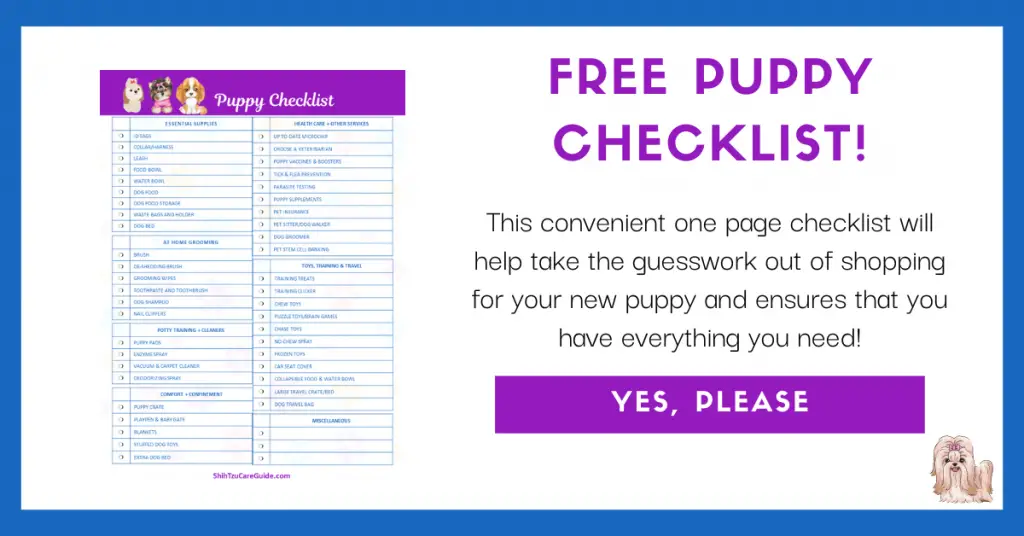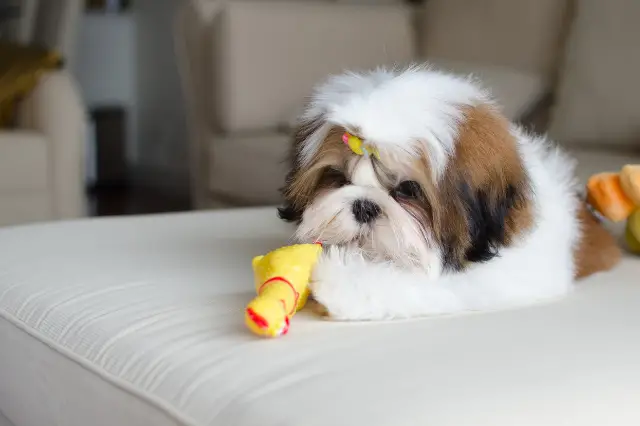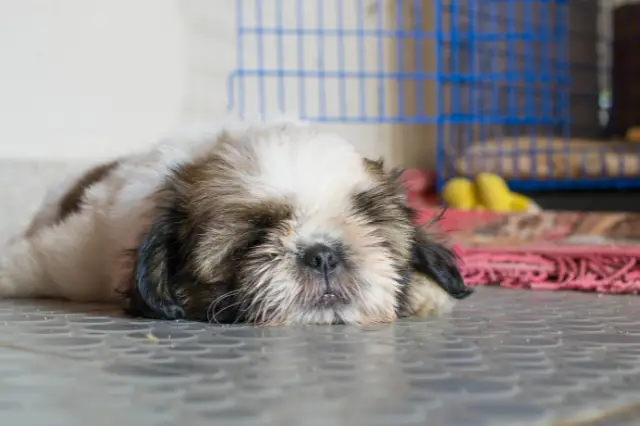If you’re like most Shih Tzu puppy owners, you may be wondering how to crate train your little one. It can be a bit daunting at first, but with patience and consistency, it can be an easy process.
With crate training, it makes housebreaking easier with less mess and you can have your Shih Tzu puppy crate trained and on his or her way to being potty trained in no time.
Let’s get started!
1. Introduce your Shih Tzu Puppy to his Crate Gradually
The first step is to get your Shih Tzu puppy used to the crate itself. You’ll want to put it in an area of your home where he or she spends a lot of time, such as the living room or kitchen.
Put a soft blanket or towel inside and leave the door open so they can come and go as they please. You may even want to put some of their favorite toys inside to make it more inviting.
Let them explore and get comfortable with their crate on their own terms. Once they seem comfortable, you can move on to the next step.
If your puppy is resistant or scared of the crate, try not to force them inside. This will only make the crate training process more difficult. Instead, try bribing them with a treat or their favorite toy.
Toss the treat or toy inside and let them go in on their own to get it. Once they’re inside, calmly praise them and give them lots of love and attention.
With time and patience, your puppy will eventually come to see the crate as a safe and comfortable space.
Keep reading for the next six steps on crate training your Shih Tzu puppy!
2. Put your Puppy in the Crate for Short Periods of Time While your Home
Now that your Shih Tzu puppy is comfortable with his crate, it’s time to start crate training.
Start by putting them in their crate for short periods of time while you are home.
At first, they may whine or cry to be let out, but it’s important to ignore these behaviors and only let them out when they’re quiet. If you give in and let them out every time they cry, they’ll learn that crying is what gets them what they want, and crate training will become more difficult.
It’s important to crate train your puppy gradually so they don’t become anxious or stressed. Start with short periods of time and gradually increase the amount of time they’re in their crate.
If you try to crate them for too long at first, it will only make the process more difficult.
Remember to always give them plenty of praise and love when they’re quiet in their crate. This will reinforce the positive behavior and make crate training easier.
This will take time and patience so don’t get discouraged if it takes a few weeks or even months to crate train your puppy.

3. Let your Puppy Out of the Crate to Potty Frequently
One of the most important aspects of crate training is letting your Shih Tzu puppy out of his crate to potty frequently.
Puppies have small bladders and can’t hold their urine for very long.
As they get older, they’ll be able to hold for longer periods of time and you can start crate training overnight.
Whenever you let your puppy out of his crate, take him straight to his designated potty area so he knows that’s where he’s supposed to go.
If he goes potty, praise him and give him a treat. If he doesn’t go potty, don’t punish him. Just put him back in his crate and try again in a few hours.
With time and patience, your Shih Tzu puppy will learn that he has to hold it until he’s outside of his crate.
4. Don’t Crate your Puppy for too Long
As mentioned earlier, it’s important not to crate your Shih Tzu puppy for too long.
If you crate them for too long, they will likely have an accident inside their crate which defeats the purpose of crate training.
You should not crate your puppy for more than 2-4 hours at a time during the day. Most puppies can handle 6-7 hours of night crating when they are around 16 weeks old.
Don’t ever leave your puppy crated all day long. If you won’t be home due to work or other obligations, look into getting a pet-sitter or consider a day care setting as an option.

5. Be Consistent with Crate Training
Crate training is a gradual process that takes time and patience. The most important thing to remember is to be consistent.
If you’re not consistent with crate training, your puppy will quickly become confused, and the crate will no longer be a safe and comfortable space for them.
Whenever you put your puppy in their crate, make sure to do it at the same time each day. This will help them understand that crate time is a regular part of their routine.
Same goes for when you let them out of their crate, make sure to do it at the same time each day as well.
6. Don’t Use the Crate as a Punishment
The crate should be a safe and comfortable space for your puppy, not a place they’re afraid of.
If you use the crate as a punishment, it will only make crate training more difficult, and it may even cause your puppy to develop anxiety or stress.
Whenever you put your puppy in their crate, make sure to do it in a calm and gentle manner. Don’t force them into their crate and don’t yell at them.
The crate should be a positive experience for your puppy, not a negative one.
7. Be Patient
Crate training is a gradual process that takes time and patience. There will be good days and there will be bad days.
The most important thing to remember is to be patient and never give up on crate training your puppy.
With time and patience, they will learn that their crate is a safe and comfortable space.
What if Your Shih Tzu goes in the Crate?
If your Shih Tzu has an accident in their crate, don’t worry. It’s not the end of the world and it doesn’t mean you’re a bad pet parent.
It just means that you need to go back to the basics and take note of some issues that may be causing a problem:
- Is he she too young?
- Did he drink too much water before being crated?
- Is the crate too big?
- Does the crate need to be moved to a different location?
- Is he too stressed out?
- Is there a medical reason, such as a urinary tract infection?
When your puppy has an accident in the crate, be sure to clean it up immediately with an enzymatic cleaner. This will help to remove the scent of urine and make it less likely for your puppy to have another accident in that spot.
If the problem persists, contact your veterinarian to rule out any medical issues.
Final Thoughts
Crate training your Shih Tzu puppy can be an easy process. By following these simple steps, you’ll have your puppy crate trained in no time.
Most importantly, remember to be patient and consistent. Crate training is a gradual process that takes time and patience. There will be good days and there will be bad days.
With time and patience, your puppy will learn that their crate is a safe and comfortable space.


